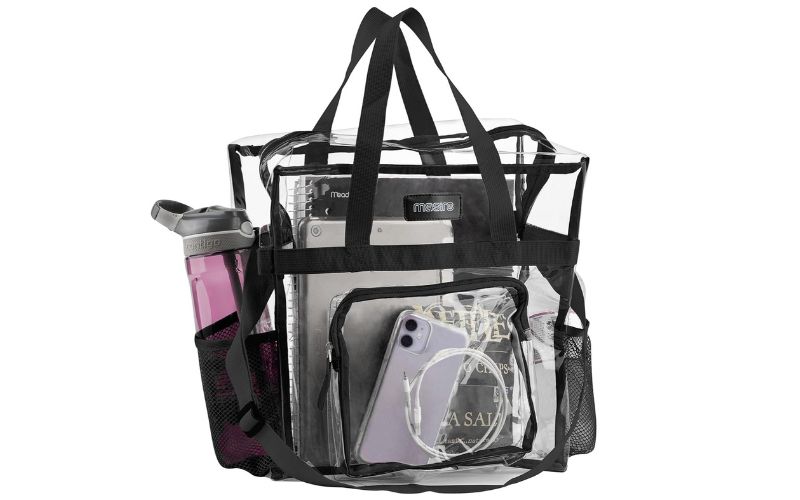How Much Weight Can a Plastic Tote Bag Hold?
Aug 22, 2024

When determining the weight a plastic tote bag can hold, several factors must be considered, like material thickness, construction quality, and design features. Standard bags usually support 10 to 30 pounds, but some reinforced options can handle more. It’s important to follow the manufacturer’s guidelines for weight limits and test the bag’s capacity gradually. Overloading can cause damage, so distributing the weight evenly and inspecting the bag regularly is essential.
Upgrade your organization with our Clear Tote Bag – stylish, spacious, and perfect for any occasion!
How Much Weight Can A Plastic Tote Bag Hold?
Plastic tote bags, also called disposable shopping bags, are often underestimated in their tensile strength and durability. Tensile strength is the greatest pulling force a material can handle before it breaks. The resistance of plastic bags depends on various factors, including their thickness, manufacturing quality, and intended use.
Studies have shown that standard plastic grocery bags—typically handed out in stores—can hold anywhere from 10 to 17 pounds. However, heavier-duty plastic tote bags, such as those used by some grocery stores or promotional companies, can handle weights up to 20 or even 50 pounds, depending on their size and material composition. The selection of the right bag, whether for carrying groceries or other items, can make a significant difference in the results you experience.
Factors Affecting Weight Capacity
Several key factors directly impact the weight capacity of a plastic tote bag.
Thickness
One primary aspect to consider is the thickness of the plastic. Thicker plastic tote bags generally have a higher weight capacity, allowing you to carry heavier items without worrying about the bag tearing or stretching. Most standard plastic tote bags are designed to handle lightweight to moderately heavy items, usually within the range of 10 to 30 pounds.
Material and Construction
The material and construction of a plastic tote bag play important roles in determining its weight capacity. When choosing a plastic tote bag, pay attention to the thickness of the plastic. Thicker materials generally support heavier weights, making them more reliable for carrying bulkier items.
Construction details like stitching and handles are equally essential. Bags with reinforced stitching and sturdy handles can hold up to 50 pounds or more. The stitching should be tight and secure, ensuring the bag can withstand the pressure of heavy loads without tearing. Handles should be robust and well-attached to distribute weight evenly and provide comfortable carrying.
Bag Size and Volume
The size and volume of a plastic bag directly correlate to its weight capacity. Larger grocery bags or totes with reinforced handles can hold more items, while smaller disposable bags may tear under excessive strain. The company producing the bag often provides information about its capacity, though this information is not always clearly displayed to customers.
Design Features
Reinforced handles, double seams, and gusseted sides increase plastic tote bags' durability and load capacity. These design elements prevent the bag from breaking under high stress, ensuring a longer product life.
Usage Conditions
Environmental factors like temperature and humidity can affect the strength of plastic bags. For instance, exposure to direct sunlight over time weakens the material, while cold temperatures can make it brittle.
Safety Tips for Use
Always check the manufacturer’s guidelines before loading your plastic tote bag to ensure you don’t exceed its weight capacity. Exceeding the specified limit can lead to tears or damage, compromising safety. Most plastic tote bags have weight capacities ranging from 10 to 50 pounds, so knowing your bag’s limit is important.
When using reusable bags for grocery shopping, distribute the weight evenly to avoid stressing any single point of the bag. Place heavier items like canned goods at the bottom and lighter items on top. This not only protects the bag but also makes carrying easier.
Consider the type of items you’re planning to carry. Some heavy-duty plastic tote bags are designed to hold up to 50 pounds, making them ideal for groceries, books, or other heavy items. However, always be mindful of the bag’s capacity to prevent accidents.
Inspect your bag for any signs of wear and tear before each use. Small tears or weakened handles can quickly worsen under stress, leading to potential spills or injuries.
Comparing Plastic Bags To Alternatives
While plastic bags are convenient and cost-effective, they’re often criticized for their environmental impact. In the United States alone, millions of tons of plastic waste end up in landfills each year, contributing to environmental pollution. However, in certain metrics, their durability and energy efficiency during production often outperform paper bags and some reusable options.
Plastic vs. Paper Bags: Due to their biodegradability, paper bags are often considered eco-friendly. However, studies reveal that paper bag production consumes significantly more water and energy than plastic bag production. Paper bags also have less tensile strength and are more likely to break when carrying heavy or wet items. This means customers often need to double up, increasing the amount of paper used.
Plastic vs. Reusable Bags: Reusable bags are a more sustainable option, but their environmental benefits depend on repeated use. The energy required to produce a single reusable bag is far greater than a disposable plastic bag. Therefore, a reusable bag must be used dozens or even hundreds of times to offset its environmental impact. Of course, reusable bags come in various sizes and bag materials, making them a versatile choice for customers looking to reduce their ecological footprint.
Comments From Social Media
The conversation around plastic tote bags is active, particularly on platforms like Instagram. Customers frequently share their thoughts and experiences with various bag types, offering real-world insights into their durability and environmental impact. Some comments highlight the surprising strength of plastic bags, while others emphasize the need for better recycling initiatives and alternatives.
Conclusion
When using a plastic tote bag, consider the material and construction to determine its weight capacity. Test the bag gradually with added weight and never exceed the manufacturer’s specifications. Distribute the load evenly and inspect for signs of wear and tear before each use. By following these safety tips and comparing different brands, you can guarantee that your tote bag performs reliably and lasts longer.
Frequently Asked Questions
How much weight can a standard plastic grocery bag hold?
Most standard plastic grocery bags can hold 10 to 17 pounds, depending on the material quality and manufacturing design.
Are thicker plastic bags stronger than thinner ones?
Not necessarily. Due to their material properties, high-density polyethylene (HDPE) bags, though thinner, are often stronger than low-density polyethylene (LDPE) bags.
Can plastic tote bags be reused multiple times?
Many plastic tote bags can be reused several times, especially if not damaged. Reusing them helps reduce their environmental impact.
Are there environmentally friendly ways to dispose of plastic bags?
Yes, many stores offer recycling programs specifically for plastic bags. Using these programs to prevent plastic waste from ending up in landfills or oceans is important.


